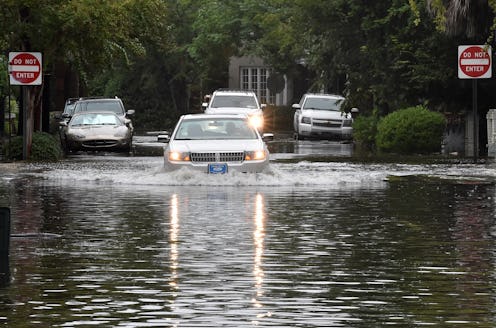News
These Photos Of Catastrophic Flooding In Downtown Charleston Are Horrifying

Hurricane Irma is showing no signs of letting up, and although much focus has been placed on the storm's effects in Florida and the Caribbean, it's had catastrophic effects elsewhere in the country as well. On Monday, Hurricane Irma caused catastrophic flooding in Charleston, South Carolina. At least one person in the city has died, and as pictures illustrate, the floods have made swaths of the city nearly impossible to navigate.
As of Monday, Irma was around 200 miles away from Charleston, and yet it's so massive that its effects were felt well beyond the storm's epicenter. Much of this was due to the hurricane's storm surge, which occurs when a hurricane "pushes" excess ocean water toward the shores as it approaches a coast. The result is flooding, and often, storm surge is the most dangerous part of a hurricane.
To make matters worse, Charleston's water levels were already at high tide when Irma's storm surge hit; in conjunction with the storm surge, this produced a 9.9-foot tide. That's more than 4 feet over normal levels in the city, according to The Post and Courier, and amongst the three highest tidal surges Charleston has experienced in the last 80 years.
24 Hours of Flooding
Charleston was hit with a 9.9-foot tide and storm surge on Monday, flooding much of the downtown region. Although levels have slightly receded since peaking earlier in the day, more flooding is expected on Tuesday morning, according to The Post and Courier, and Charleston Mayor John Tecklenburg says the water may not fully recede until late Tuesday afternoon.
Street Kayaks
Flooding on Aiken Street was so severe that some people were forced to use boats to navigate the streets. In a picture posted by The Post and Courier's Brad Nettles, they can be seen using kayaks for transportation and crutches as makeshift paddles.
High Tide
The combination of the storm surge produced by Irma and high tide in surrounding waters caused substantial flooding in downtown Charleston. Some businesses and residents placed sandbags at the foot of their doors to minimize the damage.
North Market Street
Reporter Sydney Ryan of local station WCSC shared this picture of flooding on North Market Street, one of many areas in downtown Charleston that's all or partially underwater.
"Make Every Breath Count"
The Post and Courier published a roundup of flooding pictures from around Charleston, including a piece of debris with the words "MAKE EVERY BREATH COUNT" spray-painted on it.
Four Feet of Water
One eyewitness reported 4 feet of flooding at a cluster of residential homes in the city.
Floating Garbage
Downtown Charleston was flooded all over on Monday, with water reaching storefront doorknobs, overturning garbage cans, and snapping tree branches.
Completely Submerged Parking Lots
In some parts of the city, entire parking lots were flooded.
"Lake Huger"
There usually isn't a lake at the intersection of Rutledge Avenue and Huger Street, but there was on Monday.
The fact that Hurricane Irma has had such a massive effect on Charleston is a classic example of just how unpredictable hurricanes can be. It was no surprise that the storm battered Florida, Georgia, and islands in the Caribbean, as meteorologists had foreseen that for days before Irma made landfall. But Charleston was on fewer people's radars in the days leading up to the storm — although, thankfully, city officials saw it coming.
As Mayor Tecklenburg told The New York Times in an interview:
It sounds kind of counterintuitive that we'd have [flooding], because the center of the storm is over 200 miles away in western Georgia, and here we are over on the coast of South Carolina. But just if you looked at the bigger weather map and saw the counterclockwise rotation of Irma, juxtaposed with a clockwise high-pressure rotation over the Atlantic, Charleston was like in the pincer of those two motions that has driven wind and hurricane bands almost directly into our city.
If you live in Charleston — or really, anywhere remotely close to Hurricane Irma's path — it's of the utmost importance that you keep up to date on local advisories, and take them as seriously as possible.